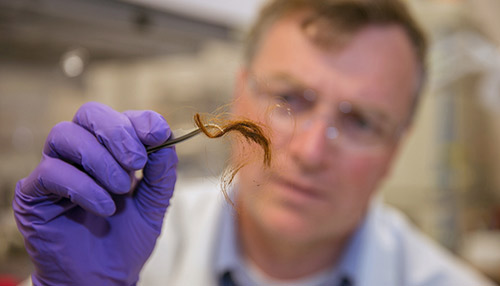



Business Inquiry
Global:
Email:marketing@medicilon.com
+1(781)535-1428(U.S.)
0044 7790 816 954 (Europe)
China:
Email: marketing@medicilon.com.cn
Tel: +86 (21) 5859-1500



DNA has met its rival (or partner) in identifying individuals in crime scenes. Scientists have discovered a new and better way in identifying someone through sequencing hair proteins.

Combing through the hair proteome, scientists from Lawrence Livermore National Laboratory (LLNL) have uncovered markers that could be used to identify individual people. Although the scientists say that their technique needs refinement, they have already shown that a panel of 185 hair protein markers is sufficient to distinguish one person out of a population of one million. The scientists anticipate that once their technique is optimized, it will be possible to use just a few hairs, or even a single hair, to identify one person out of the world’s population.
The new, protein-based approach to human identification was detailed September 7 in the journal PLoS ONE, in an article entitled, “Demonstration of Protein-Based Human Identification Using the Hair Shaft Proteome.” The article emphasizes that because protein is chemically more robust than DNA, protein analysis may join DNA analysis in forensics and archeology.
“We are in a very similar place with protein-based identification to where DNA profiling was during the early days of its development,” said LLNL chemist Brad Hart, the director of the Lab’s Forensic Science Center and co-author of the PLoS ONE paper. “This method will be a game-changer for forensics, and while we’ve made a lot of progress toward proving it, there are steps to go before this new technique will be able to reach its full potential.”
The PLoS ONE article noted that protein is not only chemically more robust than DNA, but it also contains genetic variation in the form of single amino acid polymorphisms (SAPs). These can be used to infer the status of nonsynonymous single nucleotide polymorphism alleles.
“We used mass spectrometry-based shotgun proteomics to characterize hair shaft proteins in 66 European-American subjects,” the authors of the PLoS ONE article wrote. “A total of 596 single nucleotide polymorphism alleles were correctly imputed in 32 loci from 22 genes of subjects’ DNA and directly validated using Sanger sequencing.”
The LLNL also examined hair from five African Americans, five Kenyans, and six skeletal remains from the 1750s and 1850s. Ultimately, the scientists found a total of 185 protein markers. The scientists also determined that each person’s number of hair protein markers, combined with their pattern of protein markers, is unique.
The researchers believe that the number of individual protein markers that can be used to differentiate people could go as high as 1000. Protein markers also can be found in other tissue types, such as shed skin cells, bones, and teeth, and the scientists have started studying how people can be identified using the latter two tissues.
The LLNL team’s research kicked into high gear in March 2013 when biochemist Glendon Parker, the inventor of the protein identification concept and then an associate professor at Utah Valley University, came to work at LLNL. Parker is the lead author of the PLoS ONE paper.
“Glendon’s clever invention was to realize that the uniqueness of SAPs could be used to identify individual people, and the robustness of the technique relies on its link back to DNA,” said Deon Anex, an LLNL chemist and co-author.
Although people do not inherit proteins, they do inherit the DNA that produces their proteins.
“As a result, there is a link between the protein markers that we find and a person’s DNA. There are two reasons why this is particularly important: the DNA is unique to each individual and it is inherited from a person’s parents,” Anex added.
Currently, the sample preparation, instrument run time, and analysis period for the protein identification method requires about 2 1/2 days, Anex said, noting the team expects the cost to be competitive with other similar technologies.
“The discovery phase has been quite complex, but once the technique is established, we believe it can be made into a routine procedure for use in crime labs.”
The researchers are seeking to establish a set of 90–100 protein markers that would be sufficient to distinguish an individual among the world’s population using a single hair.
 Relevant
news
Relevant
news